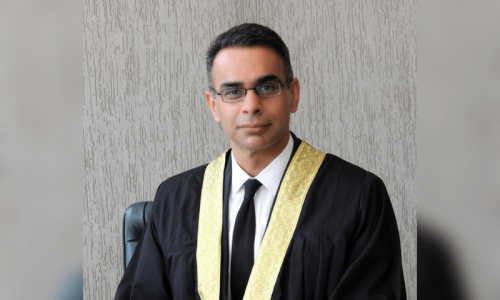THE process of devolution of power to federating units started by the 18th Amendment has generated extremely useful discussions on these units’ economic potential and their capacity to properly use the newly acquired authority and financial resources.
Some time ago, Dr Kaiser Bengali offered an account of Balochistan’s deprivations and pointed out the possibilities of its economic recovery and progress. Now Dr Ishrat Husain, Prof Aijaz Qureshi and Nadeem Hussain (a young scholar) and Oxford University Press have joined hands to produce a 500-page study on The Economy of Modern Sindh, and discussed “opportunities lost and lessons for the future”.
A first look at the contents, from ‘Land and People’ to ‘Public Finance, Taxation and Resource Mobilisation’ suggests that the book might be one of those annual reports the Sindh government has been publishing to introduce the readers to basic facts about the province and its own achievements. It is not like one of those unreadable publicity vehicles. It is also distinguishable from the federal Economic Survey because it does not gloss over governments’ deficiencies and failure with unconvincing explanations.
In this study, the authors draw upon both official statistics and civil society researches — by Arif Hasan and Hafiz Pasha, for instance — while analysing Sindh’s potential and problems. They are not afraid of polemics, nor of the echoes of the Sindhi nationalist arguments in their narrative.
The findings of a study on Sindh assume special significance when confirmed by empirical evidence.
Thus, at the very beginning, the authors take note of the federal-Sindh conflict over licensing for oil and gas exploration, and differences with the Higher Education Commission over the formation of the provincial HEC. While they are prepared to concede that the “effective implementation of provincial autonomy will take some time”, they don’t hide their disappointment that “the third tier of the government — local governments — has been weakened by the new laws passed by Punjab, Sindh and Balochistan”.
They also emphasise the decline in the rate of growth in per capita income and express due concern over the fact that while “Karachi has the highest per capita income and the highest ranking across various social indicators while some of the districts in rural Sindh are among the poorest in the country ... The social gap between the urban males and rural females is wide and interpersonal income, gender and rural-urban inequalities have worsened over time”.
Some of these findings are common knowledge but they assume special significance when confirmed by empirical evidence.
The application of critical tests to trends in various fields of activity can be seen in almost all chapters. For instance, while discussing deeni madressahs in the chapter on education, the study observes that madressahs “today are associated with obscurantism and conservative attitudes in thought and practice”. Some of them are alleged to have become breeding grounds of fanatics and extremists. After noting the increase in the number of madressahs from 189 at the time of Independence to 40,000 in 2008, the study does well to draw attention to the challenge of absorbing 300,000 to 400,000 madressah graduates annually.
In the section on health, the study calls for an integrated, multisectoral strategy, especially the devolution of primary and secondary healthcare to local governments.
Likewise in the chapter on labour, the authors candidly accept the existence of bonded labour in the province and attribute it to the dominance of powerful feudal landlords and the tenant-landlord relationship being in their favour.
This discussion continues in the chapter on agriculture: “The consequential legacy of a rich and powerful class of landlords enjoying large concentration of wealth and income, and a poor, deprived peasant population subservient to and dependant on this class, has created difficulties in terms of economic efficiency, equity, democratic governance and capture of state institutions.” The concentration of land ownership is getting diluted with the passage of time “but the large landowners in the rural areas of Sindh still continue to exercise disproportionate influence both on politics and agrarian economy. They own not only the lands but also the people who work on them”.
In a well-written chapter on poverty, the authors note a decline in overall poverty but emphasise the hardships faced in quite a few districts and are worried about lack of efficiency in using resources for poverty alleviation. They appreciate the use of the Multipurpose Poverty Index that takes into account, besides income differentials, access to education and health and the standard of life, and which finds 43.1 per cent of the Sindh population living below MPI as against the national average of 39pc.
The chapter on energy and mineral resources is remarkable for the amount of information about the generation of electricity and patterns of consumption. Similarly, the chapter on public finance offers a complete history of the division of resources between the federation and the provinces, from the Niemeyer Award under the Government of India Act of 1935 and the Raisman Award of 1951 to the seventh NFC Award of 2009.
In addition, the wealth of information presented in statistical tables and graphs makes the study an extremely valuable reference book.
The study was begun as an effort to update the Economy of Modern Sindh, published by the Institute of Sindhology in 1981, and is primarily meant to serve as a textbook for college and university students. However, it should serve a wider purpose by helping students of politics, commentators on economic affairs and policymakers base their opinions on a correct appreciation of the ground realities.
If Punjab and Khyber Pakhtunkhwa could also prepare similar studies, the collection would form a matchless aide to politicians and citizens alike and facilitate the emergence of an informed citizenry that is one of the basic requisites for democratic governance. This is the kind of knowledge that is equal to power.
Published in Dawn, April 25th, 2019















































